Sentinel-2 Poplar Index for Operational Mapping of Poplar Plantations over Large Areas
Abstract
:1. Introduction
2. Materials
2.1. Satellite Data
2.2. Reference Data
3. Methods
3.1. Feature Selection with SFFS
3.2. Sample Selection, Classification and Comparison of Performances
3.3. Sentinel-2 Poplar Detection Index (PI)
3.4. National Mapping of Poplar Plantations
4. Results
4.1. Multi-Feature SFFS
4.2. Single-Feature SFFS
4.3. Predictive Performances Using Another Independent Dataset
4.4. National Map of Poplar Plantations Using the PI Index
5. Discussion
5.1. Single-Feature vs. Multi-Feature: Less Is More
5.2. S2 Spectral Bands in the SWIR and Red Edge Domains Are Required to Identify Poplar
5.3. Poplar Recognition Is Not Driven by Phenological Differences with the Other Deciduous Species
5.4. The National Map of Poplar Plantations Requires Field Validation
6. Conclusions
- There is no added value to be obtained by combining multiple spectral bands or different spectral indices at different dates to classify poplar accurately. If optimal features are selected, a multi-temporal single-feature approach provides equivalent results.
- Only a few dates are required to identify poplar among deciduous species, the optimal period being the growing season; no significant improvement is achieved beyond four or five acquisition dates, but adding more dates can make the classification more robust to residual noise at the national scale without being affected by the curse of dimensionality (because of the single-feature strategy). Using the PI poplar index, the best three dates are between May and August, with an additional date in October.
- SWIR followed by red edge spectral regions are the most useful to differentiate poplars from other deciduous species. This reflects the sensitivity of poplar trees to water content throughout their phenological cycle. The best S2 spectral bands are B11, B12, B5, and B6. The best performances with stable results regardless of the year were obtained when some of these bands were combined through the PI poplar index. Significant but limited differences were found with the PI or SIWSI indices (which are the other competitive ones).
- Because the model was trained using reference samples of deciduous species only, the national map of poplar plantations strongly depends on the quality of the forest/non-forest layer used to mask the unfocused areas.
Author Contributions
Funding
Data Availability Statement
Conflicts of Interest
Appendix A. Resampled Dates for 2017 and 2018 Time Series
| Resampled Dates (in 2017) | Resampled Dates (in 2018) |
|---|---|
| NA | 6 January 2018 |
| NA | 16 January 2018 |
| 26 January 2017 | 26 January 2018 |
| 5 February 2017 | 5 February 2018 |
| 15 February 2017 | 15 February 2018 |
| 25 February 2017 | 25 February 2018 |
| 7 March 2017 | 7 March 2018 |
| 17 March 2017 | 17 March 2018 |
| 27 March 2017 | 27 March 2018 |
| 6 April 2017 | 6 April 2018 |
| 16 April 2017 | 16 April 2018 |
| 26 April 2017 | 26 April 2018 |
| 6 May 2017 | 6 May 2018 |
| 16 May 2017 | 16 May 2018 |
| 26 May 2017 | 26 May 2018 |
| 5 June /2017 | 5 June 2018 |
| 15 June 2017 | 15 June 2018 |
| 25 June /2017 | 25 June 2018 |
| 5 July 2017 | 5 July 2018 |
| 15 July 2017 | 15 July 2018 |
| 25 July 2017 | 25 July 2018 |
| 4 August 2017 | 4 August 2018 |
| 14 August 2017 | 14 August 2018 |
| 24 August 2017 | 24 August 2018 |
| 3 September 2017 | 3 September 2018 |
| 13 September 2017 | 13 September 2018 |
| 23 September /2017 | 23 September 2018 |
| 3 October 2017 | 3 October 2018 |
| 13 October 2017 | 13 October 2018 |
| 23 October 2017 | 23 October 2018 |
| 2 November 2017 | 2 November 2018 |
| 12 November 2017 | 12 November 2018 |
| 22 November 2017 | 22 November 2018 |
| 2 December /2017 | 2 December 2018 |
| 12 December 2017 | 12 December 2018 |
| 22 December 2017 | 22 December 2018 |
Appendix B. Correlation between the Poplar Index (PI) Variants
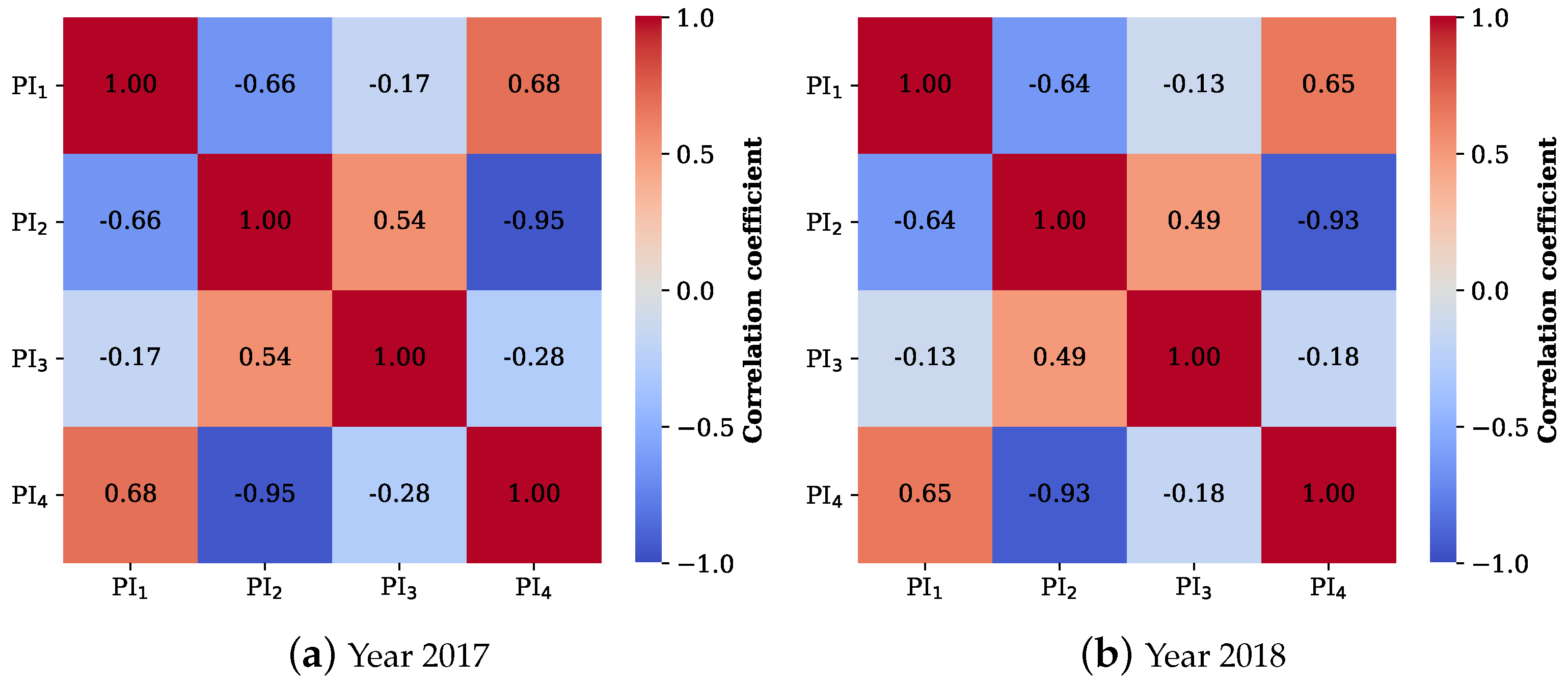
Appendix C. Additional Spectral Indices Tested
| Indices | Formulas | References | |
|---|---|---|---|
| Normalised Difference Moisture Index | NDMI = | [99] | |
| Normalised Difference Snow Index | NDSI = | [100] | |
| Normalised Difference Water Index | NDWI = | [65] | |
| Bare Soil Index | BSI = | [101] | |
| Normalised Difference Salinity Index | NDSI2 = | [102] | |
| Burned Area Index for Sentinel-2 | BAIS2 = | [103] | |
| Inverted Red-Edge Chlorophyll Index | IRECI = | [104] | |
Appendix D. McNemar Test p-Values
| Band 11 | Band 12 | PI | SIWSI | Bands | Indices | PI | PI | PI | ||
|---|---|---|---|---|---|---|---|---|---|---|
| Year 2017 | Band 5 | <0.001 | <0.001 | <0.001 | <0.001 | 0 | 0 | <0.001 | <0.001 | <0.001 |
| Band 11 | - | <0.001 | <0.001 | <0.001 | <0.001 | <0.001 | <0.001 | <0.001 | <0.001 | |
| Band 12 | - | - | <0.001 | 0.097 | <0.001 | <0.001 | <0.001 | <0.001 | 0.041 | |
| PI | - | - | - | <0.001 | <0.001 | <0.001 | <0.001 | <0.001 | <0.001 | |
| SIWSI | - | - | - | - | <0.001 | <0.001 | <0.001 | <0.001 | 0.014 | |
| Bands | - | - | - | - | - | 0.395 | <0.001 | <0.001 | <0.001 | |
| Indices | - | - | - | - | - | - | <0.001 | <0.001 | <0.001 | |
| PI | - | - | - | - | - | - | - | <0.001 | <0.001 | |
| PI | - | - | - | - | - | - | - | - | <0.001 | |
| Year 2018 | Band 5 | <0.001 | <0.001 | <0.001 | <0.001 | <0.001 | <0.001 | <0.001 | <0.001 | <0.001 |
| Band 11 | - | <0.001 | <0.001 | <0.001 | <0.001 | <0.001 | <0.001 | <0.001 | 0.015 | |
| Band 12 | - | - | <0.001 | <0.001 | <0.001 | <0.001 | 0.069 | <0.001 | <0.001 | |
| PI | - | - | - | <0.001 | 0.523 | <0.001 | <0.001 | 0 | <0.001 | |
| SIWSI | - | - | - | - | <0.001 | <0.001 | <0.001 | <0.001 | <0.001 | |
| Bands | - | - | - | - | - | <0.001 | <0.001 | 0 | <0.001 | |
| Indices | - | - | - | - | - | - | <0.001 | 0 | <0.001 | |
| PI | - | - | - | - | - | - | - | <0.001 | <0.001 | |
| PI | - | - | - | - | - | - | - | - | <0.001 |
| Year | Poplar PA Scores | PI | PI | PI |
|---|---|---|---|---|
| 2017 | test score | 84.9 | 73.9 | 88.3 |
| 2018 | test score | 89.7 | 73.3 | 92.2 |
Appendix E. Confusion Matrix of the Classification Based on PI2 in the Single-Feature Configuration for Year 2018
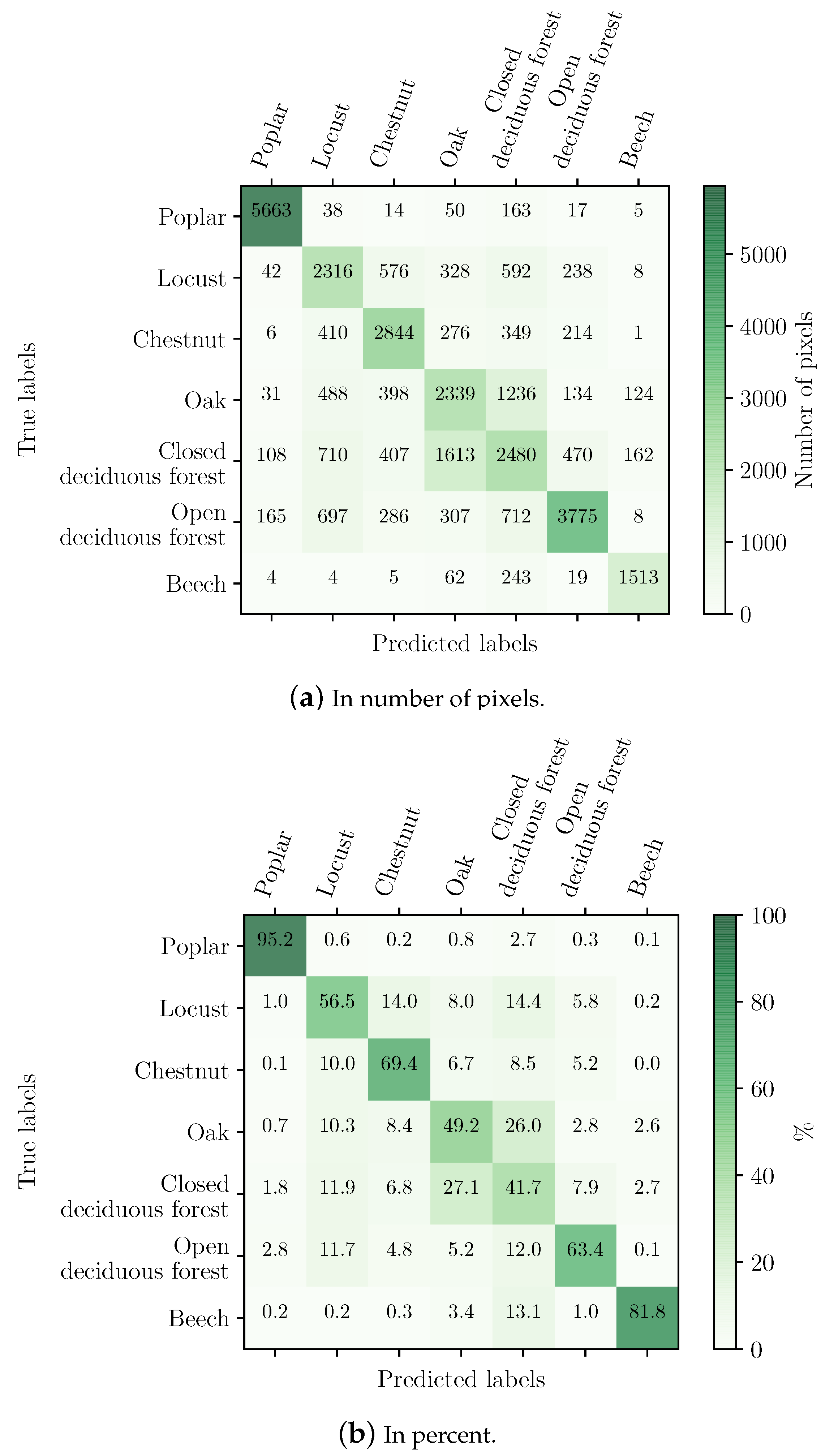
Appendix F. Spectral Signatures



References
- Fares, S.; Mugnozza, G.; Corona, P.; Palahí, M. Sustainability: Five steps for managing Europe’s forests. Nature 2015, 519, 407–409. [Google Scholar] [CrossRef] [PubMed]
- FAO. Global Forest Resources Assessment 2020: Key Findings; FAO: Rome, Italy, 2020. [Google Scholar]
- Carle, J.; Holmgren, P. Wood from planted forests. For. Prod. J. 2008, 58, 6. [Google Scholar]
- FAO. Poplars and Other Fast-Growing Trees—Renewable Resources for Future Green Economies; Synthesis of Country Progress Reports: Berlin, Germany, 2016. [Google Scholar]
- Boyd, D.; Danson, F. Satellite remote sensing of forest resources: Three decades of research development. Prog. Phys. Geogr. 2005, 29, 1–26. [Google Scholar] [CrossRef]
- Reitberger, J.; Krzystek, P.; Stilla, U. Analysis of Full Waveform LIDAR Data for the Classification of Deciduous and Coniferous Trees. Int. J. Remote Sens. 2008, 29, 1407–1431. [Google Scholar] [CrossRef]
- Hansen, J.; Mitchard, E.A.; King, S. Assessing Forest/Non-Forest Separability Using Sentinel-1 C-Band Synthetic Aperture Radar. Remote Sens. 2020, 12, 1899. [Google Scholar] [CrossRef]
- Immitzer, M.; Atzberger, C.; Koukal, T. Tree Species Classification with Random Forest Using Very High Spatial Resolution 8-Band WorldView-2 Satellite Data. Remote Sens. 2012, 4, 2661–2693. [Google Scholar] [CrossRef]
- Sheeren, D.; Fauvel, M.; Josipović, V.; Lopes, M.; Planque, C.; Willm, J.; Dejoux, J.F. Tree Species Classification in Temperate Forests Using Formosat-2 Satellite Image Time Series. Remote Sens. 2016, 8, 734. [Google Scholar] [CrossRef]
- Fassnacht, F.E.; Latifi, H.; Stereńczak, K.; Modzelewska, A.; Lefsky, M.; Waser, L.T.; Straub, C.; Ghosh, A. Review of Studies on Tree Species Classification from Remotely Sensed Data. Remote Sens. Environ. 2016, 186, 64–87. [Google Scholar] [CrossRef]
- Persson, M.; Lindberg, E.; Reese, H. Tree Species Classification with Multi-Temporal Sentinel-2 Data. Remote Sens. 2018, 10, 1794. [Google Scholar] [CrossRef]
- Torbick, N.; Ledoux, L.; Salas, W.; Zhao, M. Regional Mapping of Plantation Extent Using Multisensor Imagery. Remote Sens. 2016, 8, 236. [Google Scholar] [CrossRef]
- Li, Z.; Fox, J.M. Mapping Rubber Tree Growth in Mainland Southeast Asia Using Time-Series MODIS 250 m NDVI and Statistical Data. Appl. Geogr. 2012, 32, 420–432. [Google Scholar] [CrossRef]
- Ye, S.; Rogan, J.; Sangermano, F. Monitoring Rubber Plantation Expansion Using Landsat Data Time Series and a Shapelet-Based Approach. ISPRS J. Photogramm. Remote Sens. 2018, 136, 134–143. [Google Scholar] [CrossRef]
- Xiao, C.; Li, P.; Feng, Z. Monitoring Annual Dynamics of Mature Rubber Plantations in Xishuangbanna during 1987-2018 Using Landsat Time Series Data: A Multiple Normalization Approach. Int. J. Appl. Earth Obs. Geoinf. 2019, 77, 30–41. [Google Scholar] [CrossRef]
- Puttinaovarat, S.; Horkaew, P. Deep and Machine Learnings of Remotely Sensed Imagery and Its Multi-Band Visual Features for Detecting Oil Palm Plantation. Earth Sci. Inform. 2019, 12, 429–446. [Google Scholar] [CrossRef]
- Descals, A.; Szantoi, Z.; Meijaard, E.; Sutikno, H.; Rindanata, G.; Wich, S. Oil Palm (Elaeis Guineensis) Mapping with Details: Smallholder versus Industrial Plantations and Their Extent in Riau, Sumatra. Remote Sens. 2019, 11, 2590. [Google Scholar] [CrossRef]
- Le Maire, G.; Dupuy, S.; Nouvellon, Y.; Loos, R.A.; Hakamada, R. Mapping Short-Rotation Plantations at Regional Scale Using MODIS Time Series: Case of Eucalypt Plantations in Brazil. Remote Sens. Environ. 2014, 152, 136–149. [Google Scholar] [CrossRef]
- Forstmaier, A.; Shekhar, A.; Chen, J. Mapping of Eucalyptus in Natura 2000 Areas Using Sentinel 2 Imagery and Artificial Neural Networks. Remote Sens. 2020, 12, 2176. [Google Scholar] [CrossRef]
- Deng, X.; Guo, S.; Sun, L.; Chen, J. Identification of Short-Rotation Eucalyptus Plantation at Large Scale Using Multi-Satellite Imageries and Cloud Computing Platform. Remote Sens. 2020, 12, 2153. [Google Scholar] [CrossRef]
- Spracklen, B.; Spracklen, D.V. Synergistic Use of Sentinel-1 and Sentinel-2 to Map Natural Forest and Acacia Plantation and Stand Ages in North-Central Vietnam. Remote Sens. 2021, 13, 185. [Google Scholar] [CrossRef]
- Heyman, O.; Gaston, G.; Kimerling, A.; Campbell, J. A Per-Segment Approach to Improving Aspen Mapping from High-Resolution Remote Sensing Imagery. J. For. 2003, 101, 29–33. [Google Scholar]
- Viinikka, A.; Hurskainen, P.; Keski-Saari, S.; Kivinen, S.; Tanhuanpää, T.; Mäyrä, J.; Poikolainen, L.; Vihervaara, P.; Kumpula, T. Detecting European Aspen (Populus Tremula L.) in Boreal Forests Using Airborne Hyperspectral and Airborne Laser Scanning Data. Remote Sens. 2020, 12, 2610. [Google Scholar] [CrossRef]
- Kivinen, S.; Koivisto, E.; Keski-Saari, S.; Poikolainen, L.; Tanhuanpää, T.; Kuzmin, A.; Viinikka, A.; Heikkinen, R.K.; Pykälä, J.; Virkkala, R.; et al. A Keystone Species, European Aspen (Populus Tremula L.), in Boreal Forests: Ecological Role, Knowledge Needs and Mapping Using Remote Sensing. For. Ecol. Manag. 2020, 462, 118008. [Google Scholar] [CrossRef]
- Chardenon, J.; Flouzat, G. The application of remote sensing to poplar growing: Identification and inventory of poplar groves, prediction of timber production; France, Italy. Rev. For. Fr. 1981, 33, 478–493. [Google Scholar] [CrossRef]
- Borry, F.C.; de Roover, B.P.; Leysen, M.M.; de Wulf, R.R.; Goossens, R.E. Evaluation of SPOT and TM Data for Forest Stratification: A Case Study for Small-Size Poplar Stands. IEEE Trans. Geosci. Remote Sens. 1993, 31, 483–490. [Google Scholar] [CrossRef]
- Grignetti, A.; Coaloa, D.; Niccolini, G. Classification of poplar stand areas by high-resolution satellite images. Forest 2009, 6, 299–311. [Google Scholar] [CrossRef]
- Eslami, A.; Zahedi, S.S. Providing Poplar Plantation Map by Indian Remote Sensing (IRS) Satellite Imagery in Northern Iran. Afr. J. Agric. Res. 2011, 6, 4769–4774. [Google Scholar]
- D’Amico, G.; Francini, S.; Giannetti, F.; Vangi, E.; Travaglini, D.; Chianucci, F.; Mattioli, W.; Grotti, M.; Puletti, N.; Corona, P.; et al. A deep learning approach for automatic mapping of poplar plantations using Sentinel-2 imagery. Gisci. Remote Sens. 2021, 58, 1352–1368. [Google Scholar] [CrossRef]
- Hościło, A.; Lewandowska, A. Mapping Forest Type and Tree Species on a Regional Scale Using Multi-Temporal Sentinel-2 Data. Remote Sens. 2019, 11, 929. [Google Scholar] [CrossRef]
- Karasiak, N.; Dejoux, J.F.; Fauvel, M.; Willm, J.; Monteil, C.; Sheeren, D. Statistical Stability and Spatial Instability in Mapping Forest Tree Species by Comparing 9 Years of Satellite Image Time Series. Remote Sens. 2019, 11, 2512. [Google Scholar] [CrossRef]
- Joly, D.; Brossard, T.; Cardot, H.; Cavailhes, J.; Hilal, M.; Wavresky, P. Les types de climats en France, une construction spatiale. Cybergeo Eur. J. Geogr. 2010, 501, 34–42. [Google Scholar] [CrossRef]
- IGN. La forêt plantée en France: état des lieux. L’If Feuille L’Inventaire For. 2017, 40, 10–11. [Google Scholar]
- Hagolle, O.; Huc, M.; Villa Pascual, D.; Dedieu, G. A Multi-Temporal and Multi-Spectral Method to Estimate Aerosol Optical Thickness over Land, for the Atmospheric Correction of FormoSat-2, LandSat, VENμS and Sentinel-2 Images. Remote Sens. 2015, 7, 2668–2691. [Google Scholar] [CrossRef]
- Inglada, J.; Vincent, A.; Arias, M.; Marais-Sicre, C. Improved Early Crop Type Identification By Joint Use of High Temporal Resolution SAR And Optical Image Time Series. Remote Sens. 2016, 8, 362. [Google Scholar] [CrossRef]
- Boureau, J.G. Manuel d’Interprétation des Photographies Aériennes Infrarouges; IFN: Saint-Jean-de-la-Ruelle, France, 2008. [Google Scholar]
- Jia, X.; Kuo, B.C.; Crawford, M.M. Feature Mining for Hyperspectral Image Classification. Proc. IEEE 2013, 101, 676–697. [Google Scholar] [CrossRef]
- Chandrashekar, G.; Sahin, F. A survey on feature selection methods. Comput. Electr. Eng. 2014, 40, 16–28. [Google Scholar] [CrossRef]
- Hughes, G. On the mean accuracy of statistical pattern recognizers. IEEE Trans. Inf. Theory 1968, 14, 55–63. [Google Scholar] [CrossRef]
- Pudil, P.; Novovičová, J.; Kittler, J. Floating Search Methods in Feature Selection. Pattern Recognit. Lett. 1994, 15, 1119–1125. [Google Scholar] [CrossRef]
- Gomez-Chova, L.; Calpe, J.; Camps-Valls, G.; Martin, J.; Soria, E.; Vila, J.; Alonso-Chorda, L.; Moreno, J. Feature selection of hyperspectral data through local correlation and SFFS for crop classification. In Proceedings of the IEEE International Geoscience and Remote Sensing Symposium (IGARSS), Toulouse, France, 21–25 July 2003; Volume 1, pp. 555–557. [Google Scholar]
- Le Bris, A.; Chehata, N.; Briottet, X.; Paparoditis, N. Use intermediate results of wrapper band selection methods: A first step toward the optimization of spectral configuration for land cover classifications. In Proceedings of the 6th Workshop on Hyperspectral Image and Signal Processing: Evolution in Remote Sensing (WHISPERS), Lausanne, Switzerland, 24–27 June 2014; pp. 1–4. [Google Scholar]
- Karasiak, N.; Dejoux, J.F.; Monteil, C.; Sheeren, D. Spatial dependence between training and test sets: Another pitfall of classification accuracy assessment in remote sensing. Mach. Learn. 2022, 111, 2715–2740. [Google Scholar] [CrossRef]
- Breiman, L. Random Forests. Mach. Learn. 2001, 45, 5–32. [Google Scholar] [CrossRef]
- Ghosh, A.; Joshi, P.K. A Comparison of Selected Classification Algorithms for Mapping Bamboo Patches in Lower Gangetic Plains Using Very High Resolution WorldView 2 Imagery. Int. J. Appl. Earth Obs. Geoinf. 2014, 26, 298–311. [Google Scholar] [CrossRef]
- Foody, G.M. Explaining the Unsuitability of the Kappa Coefficient in the Assessment and Comparison of the Accuracy of Thematic Maps Obtained by Image Classification. Remote Sens. Environ. 2020, 239, 111630. [Google Scholar] [CrossRef]
- McNemar, Q. Note on the Sampling Error of the Difference between Correlated Proportions or Percentages. Psychometrika 1947, 12, 153–157. [Google Scholar] [CrossRef] [PubMed]
- Dietterich, T.G. Approximate Statistical Tests for Comparing Supervised Classification Learning Algorithms. Neural Comput. 1998, 10, 1895–1923. [Google Scholar] [CrossRef]
- Foody, G.M. Thematic Map Comparison: Evaluating the Statistical Significance of Differences in Classification Accuracy. Photogramm. Eng. Remote Sens. 2004, 70, 627–633. [Google Scholar] [CrossRef]
- Raschka, S. MLxtend: Providing machine learning and data science utilities and extensions to Python’s scientific computing stack. J. Open Source Softw. 2018, 3, 638. [Google Scholar] [CrossRef]
- Pedregosa, F.; Varoquaux, G.; Gramfort, A.; Michel, V.; Thirion, B.; Grisel, O.; Blondel, M.; Prettenhofer, P.; Weiss, R.; Dubourg, V.; et al. Scikit-Learn: Machine Learning in Python. J. Mach. Learn. Res. 2011, 12, 2825–2830. [Google Scholar]
- Rouse, J.; Haas, R.H.; Schell, J.A.; Deering, D. Monitoring vegetation systems in the Great Plains with ERTS. In Proceedings of the 3rd Earth Resources Technology Satellite-1 Symposium, Washington, DC, USA, 10–14 December 1973; NASA Scientific and Technical Information Office: Washington, DC, USA, 1974; Volume 1, pp. 309–317. [Google Scholar]
- Hunt, E.; Rock, B.N. Detection of changes in leaf water content using Near- and Middle-Infrared reflectances. Remote Sens. Environ. 1989, 30, 43–54. [Google Scholar]
- Apan, A.; Held, A.; Phinn, S.; Markley, J. Formulation and Assessment of Narrow-Band Vegetation Indices from EO-1 Hyperion Imagery for Discriminating Sugarcane Disease. In Proceedings of the Spatial Sciences Institute Biennial Conference (SSC 2003), Canberra, Australia, 22–26 September 2003; Spatial Knowledge Without Boundaries. Spatial Sciences Institute: Canberra, Australia, 2003; pp. 1–13. [Google Scholar]
- Peñuelas, J.; Gamon, J.A.; Fredeen, A.L.; Merino, J.; Field, C.B. Reflectance Indices Associated with Physiological Changes in Nitrogen- and Water-Limited Sunflower Leaves. Remote Sens. Environ. 1994, 48, 135–146. [Google Scholar] [CrossRef]
- Key, C.; Benson, N. Landscape Assessment: Ground Measure of Severity, the Composite Burn Index; and Remote Sensing of Severity, the Normalized Burn Ratio. In FIREMON: Fire Effects Monitoring and Inventory System; USDA Forest Service: Washington, DC, USA, 2006; pp. LA1–51. [Google Scholar]
- Fensholt, R.; Sandholt, I. Derivation of a Shortwave Infrared Water Stress Index from MODIS Near- and Shortwave Infrared Data in a Semiarid Environment. Remote Sens. Environ. 2003, 87, 111–121. [Google Scholar] [CrossRef]
- Gitelson, A.A.; Merzlyak, M.; Zur, Y.; Stark, R.; Gritz, U. Non-destructive and remote sensing techniques for estimation of vegetation status. In Proceedings of the 3rd European Conference on Precision Agriculture, Montpellier, France, 18–20 June 2001; pp. 205–210. [Google Scholar]
- Rondeaux, G.; Steven, M.; Baret, F. Optimization of Soil-Adjusted Vegetation Indices. Remote Sens. Environ. 1996, 55, 95–107. [Google Scholar] [CrossRef]
- Datt, B. Remote Sensing of Water Content in Eucalyptus Leaves. Aust. J. Bot. 1999, 47, 909–923. [Google Scholar] [CrossRef]
- Cloutis, E.A.; Connery, D.R.; Major, D.J.; Dover, F.J. Airborne Multi-Spectral Monitoring of Agricultural Crop Status: Effect of Time of Year, Crop Type and Crop Condition Parameter. Int. J. Remote Sens. 1996, 17, 2579–2601. [Google Scholar] [CrossRef]
- Guerschman, J.P.; Hill, M.J.; Renzullo, L.J.; Barrett, D.J.; Marks, A.S.; Botha, E.J. Estimating Fractional Cover of Photosynthetic Vegetation, Non-Photosynthetic Vegetation and Bare Soil in the Australian Tropical Savanna Region Upscaling the EO-1 Hyperion and MODIS Sensors. Remote Sens. Environ. 2009, 113, 928–945. [Google Scholar] [CrossRef]
- Inglada, J.; Vincent, A.; Arias, M.; Tardy, B.; Morin, D.; Rodes, I. Operational High Resolution Land Cover Map Production at the Country Scale Using Satellite Image Time Series. Remote Sens. 2017, 9, 95. [Google Scholar] [CrossRef]
- Hamrouni, Y.; Paillassa, E.; Chéret, V.; Monteil, C.; Sheeren, D. From local to global: A transfer learning-based approach for mapping poplar plantations at national scale using Sentinel-2. ISPRS J. Photogramm. Remote Sens. 2021, 171, 76–100. [Google Scholar] [CrossRef]
- Gao, B.C. NDWI—A normalized difference water index for remote sensing of vegetation liquid water from space. Remote Sens. Environ. 1996, 58, 257–266. [Google Scholar] [CrossRef]
- Curran, P.J. Remote Sensing of Foliar Chemistry. Remote Sens. Environ. 1989, 30, 271–278. [Google Scholar] [CrossRef]
- Clevers, J.G.P.W.; Kooistra, L.; Schaepman, M.E. Using Spectral Information from the NIR Water Absorption Features for the Retrieval of Canopy Water Content. Int. J. Appl. Earth Obs. Geoinf. 2008, 10, 388–397. [Google Scholar] [CrossRef]
- Jacquemoud, S.; Ustin, S. Leaf Optical Properties; Cambridge University Press: Cambridge, MA, USA, 2019. [Google Scholar]
- Eitel, J.; Gessler, P.; Smith, A.; Robberecht, R. Suitability of existing and novel spectral indices to remotely detect water stress in Populus spp. For. Ecol. Manag. 2006, 229, 170–182. [Google Scholar] [CrossRef]
- Tucker, C.J.; Justice, C.O.; Prince, S.D. Monitoring the Grasslands of the Sahel 1984–1985. Int. J. Remote Sens. 1986, 7, 1571–1581. [Google Scholar] [CrossRef]
- Xi, B.; Clothier, B.; Coleman, M.; Duan, J.; Hu, W.; Li, D.; Di, N.; Liu, Y.; Fu, J.; Li, J.; et al. Irrigation management in poplar (Populus spp.) plantations: A review. For. Ecol. Manag. 2021, 494, 119330. [Google Scholar] [CrossRef]
- Zhang, H.; Morison, J.I.L.; Simmonds, L.P. Transpiration and Water Relations of Poplar Trees Growing Close to the Water Table. Tree Physiol. 1999, 19, 563–573. [Google Scholar] [CrossRef] [PubMed]
- Ceccato, P.; Flasse, S.; Tarantola, S.; Jacquemoud, S.; Grégoire, J.M. Detecting vegetation leaf water content using reflectance in the optical domain. Remote Sens. Environ. 2001, 77, 22–33. [Google Scholar] [CrossRef]
- Hosgood, B.; Jacquemoud, S.; Andreoli, G.; Verdebout, J.; Pedrini, G.; Schmuck, G. Leaf Optical Properties EXperiment 93 (LOPEX93); Technical Report Report EUR 16095 EN; European Commission, Joint Research Centre, Institute for Remote Sensing Applications: Brussels, Belgium, 1994. [Google Scholar]
- Feret, J.B.; François, C.; Asner, G.P.; Gitelson, A.; Martin, R.E.; Bidel, L.; Ustin, S.; Le Maire, G.; Jacquemoud, S. PROSPECT-4 and 5: Advances in the leaf optical properties model separating photosynthetic pigments. Remote Sens. Environ. 2008, 112, 3030–3043. [Google Scholar] [CrossRef]
- Colombo, R.; Meroni, M.; Marchesi, A.; Busetto, L.; Rossini, M.; Giardino, C.; Panigada, C. Estimation of leaf and canopy water content in poplar plantations by means of hyperspectral indices and inverse modeling. Remote Sens. Environ. 2008, 112, 1820–1834. [Google Scholar] [CrossRef]
- Morcillo-Pallarés, P.; Rivera-Caicedo, J.P.; Belda, S.; De Grave, C.; Burriel, H.; Moreno, J.; Verrelst, J. Quantifying the Robustness of Vegetation Indices through Global Sensitivity Analysis of Homogeneous and Forest Leaf-Canopy Radiative Transfer Models. Remote Sens. 2019, 11, 2418. [Google Scholar] [CrossRef]
- Gong, P.; Ruiliang, P.; Biging, G.; Larrieu, M. Estimation of forest leaf area index using vegetation indices derived from Hyperion hyperspectral data. IEEE Trans. Geosci. Remote Sens. 2003, 41, 1355–1362. [Google Scholar] [CrossRef]
- Devappa, R.; Rakshit, S.; Dekker, R. Forest biorefinery: Potential of poplar phytochemicals as value-added co-products. Biotechnol. Adv. 2015, 33, 681–716. [Google Scholar] [CrossRef]
- Kokaly, R.; Skidmore, A. Plant phenolics and absorption features in vegetation reflectance spectra near 1.66 μm. Int. J. Appl. Earth Obs. Geoinf. 2015, 43, 55–83. [Google Scholar]
- Gitelson, A.A.; Merzlyak, M.N.; Lichtenthaler, H.K. Detection of Red Edge Position and Chlorophyll Content by Reflectance Measurements Near 700 Nm. J. Plant Physiol. 1996, 148, 501–508. [Google Scholar] [CrossRef]
- Dash, J.; Curran, P.J. The MERIS Terrestrial Chlorophyll Index. Int. J. Remote Sens. 2004, 25, 5403–5413. [Google Scholar] [CrossRef]
- Dong, T.; Liu, J.; Shang, J.; Qian, B.; Ma, B.; Kovacs, J.M.; Walters, D.; Jiao, X.; Geng, X.; Shi, Y. Assessment of Red-Edge Vegetation Indices for Crop Leaf Area Index Estimation. Remote Sens. Environ. 2019, 222, 133–143. [Google Scholar] [CrossRef]
- Sun, Y.; Qin, Q.; Ren, H.; Zhang, T.; Chen, S. Red-Edge Band Vegetation Indices for Leaf Area Index Estimation From Sentinel-2/MSI Imagery. IEEE Trans. Geosci. Remote Sens. 2020, 58, 826–840. [Google Scholar] [CrossRef]
- Loozen, Y.; Rebel, K.; de Jong, S.; Lu, M.; Ollinger, S.; Wassen, M.; Karssenberg, D. Mapping canopy nitrogen in European forests using remote sensing and environmental variables with the random forests method. Remote Sens. Environ. 2020, 247, 111933. [Google Scholar] [CrossRef]
- Kyaw, T.; Siegert, C.; Dash, P.; Poudel, K.; Pitts, J.; Renninger, H. Using hyperspectral leaf reflectance to estimate photosynthetic capacity and nitrogen content across eastern cottonwood and hybrid poplar taxa. PLoS ONE 2022, 17, 1–24. [Google Scholar] [CrossRef]
- Garbulsky, M.F.; Peñuelas, J.; Gamon, J.; Inoue, Y.; Filella, I. The Photochemical Reflectance Index (PRI) and the Remote Sensing of Leaf, Canopy and Ecosystem Radiation Use Efficiencies: A Review and Meta-Analysis. Remote Sens. Environ. 2011, 115, 281–297. [Google Scholar] [CrossRef]
- Springer, K.R.; Wang, R.; Gamon, J.A. Parallel Seasonal Patterns of Photosynthesis, Fluorescence, and Reflectance Indices in Boreal Trees. Remote Sens. 2017, 9, 691. [Google Scholar] [CrossRef]
- Knyazikhin, Y.; Schull, M.; Stenberg, P.; Mõttus, M.; Rautiainen, M.; Yang, Y.; Marshak, A.; Carmona, P.; Kaufmann, R.; Lewis, P.; et al. Hyperspectral remote sensing of foliar nitrogen content. Proc. Natl. Acad. Sci. USA 2013, 110, E185–E192. [Google Scholar] [CrossRef]
- Bolyn, C.; Michez, A.; Gaucher, P.; Lejeune, P.; Bonnet, S. Forest mapping and species composition using supervised per pixel classification of Sentinel-2 imagery. Biotechnol. Agron. Soc. Environ. 2018, 22, 172–187. [Google Scholar] [CrossRef]
- Immitzer, M.; Neuwirth, M.; Böck, S.; Brenner, H.; Vuolo, F.; Atzberger, C. Optimal Input Features for Tree Species Classification in Central Europe Based on Multi-Temporal Sentinel-2 Data. Remote Sens. 2019, 11, 2599. [Google Scholar] [CrossRef]
- Grabska, E.; Frantz, D.; Ostapowicz, K. Evaluation of machine learning algorithms for forest stand species mapping using Sentinel-2 imagery and environmental data in the Polish Carpathians. Remote Sens. Environ. 2020, 251, 112103. [Google Scholar] [CrossRef]
- Bergante, S.; Facciotto, G.; Minotta, G. Identification of the Main Site Factors and Management Intensity Affecting the Establishment of Short-Rotation-Coppices (SRC) in Northern Italy through Stepwise Regression Analysis. Open Life Sci. 2010, 5, 522–530. [Google Scholar] [CrossRef]
- Sarsekova, D. Growth and Productivity of Poplar Species in Southeastern Kazakhstan. Univers. J. Plant Sci. 2015, 3, 132–140. [Google Scholar] [CrossRef]
- Villar, M.; Forestier, O. La France à la sauvegarde du Peuplier noir: état actuel du programme de conservation et de valorisation des ressources génétiques. Rev. For. FrançAise 2017, LXIX, 195–204. [Google Scholar] [CrossRef]
- Markou, M.; Singh, S. Novelty Detection: A Review—Part 1: Statistical Approaches. Signal Process. 2003, 83, 2481–2497. [Google Scholar] [CrossRef]
- Pelletier, C.; Valero, S.; Inglada, J.; Champion, N.; Marais-Sicre, C.; Dedieu, G. Effect of Training Class Label Noise on Classification Performances for Land Cover Mapping with Satellite Image Time Series. Remote Sens. 2017, 9, 173. [Google Scholar] [CrossRef]
- Dostálová, A.; Lang, M.; Ivanovs, J.; Waser, L.T.; Wagner, W. European Wide Forest Classification Based on Sentinel-1 Data. Remote Sens. 2021, 13, 337. [Google Scholar] [CrossRef]
- Cibula, W.G.; Zetka, E.F.; Rickman, D.L. Response of Thematic Mapper Bands to Plant Water Stress. Int. J. Remote Sens. 1992, 13, 1869–1880. [Google Scholar] [CrossRef]
- Valovcin, F.R. Snow/Cloud Discrimination; Number 349; Air Force Geophysics Laboratories, Air Force Systems Command, Hanscom AFB: Baltimore, MA, USA, 1976. [Google Scholar]
- Rikimaru, A.; Roy, P.; Miyatake, S. Tropical forest cover density mapping. Trop. Ecol. 2002, 43, 39–47. [Google Scholar]
- Richardson, A.D.; Duigan, S.P.; Berlyn, G.P. An evaluation of noninvasive methods to estimate foliar chlorophyll content. New Phytol. 2002, 153, 185–194. [Google Scholar] [CrossRef]
- Filipponi, F. BAIS2: Burned Area Index for Sentinel-2. Proceedings 2018, 2, 364. [Google Scholar] [CrossRef]
- Frampton, W.J.; Dash, J.; Watmough, G.; Milton, E.J. Evaluating the Capabilities of Sentinel-2 for Quantitative Estimation of Biophysical Variables in Vegetation. ISPRS J. Photogramm. Remote Sens. 2013, 82, 83–92. [Google Scholar] [CrossRef]


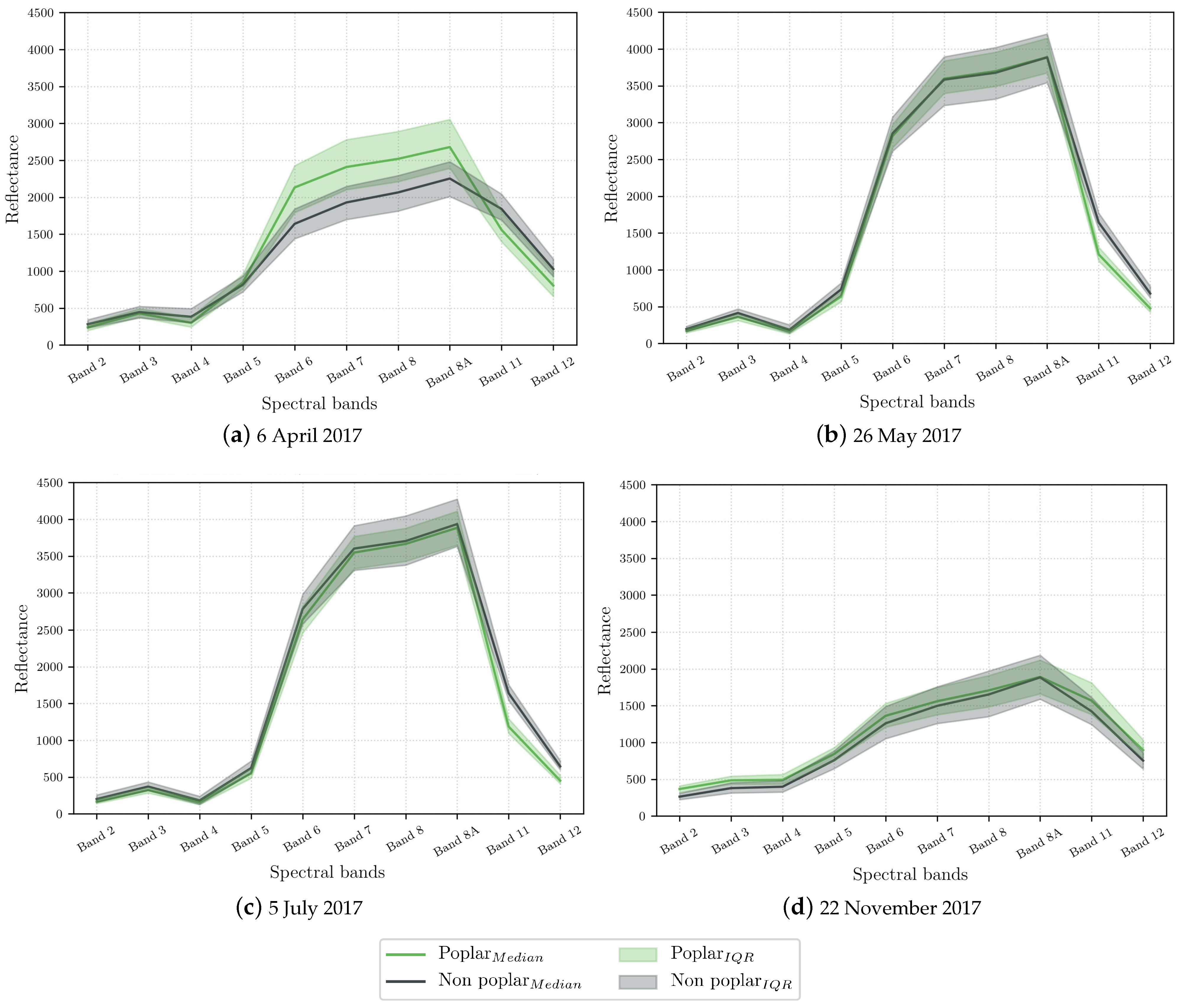

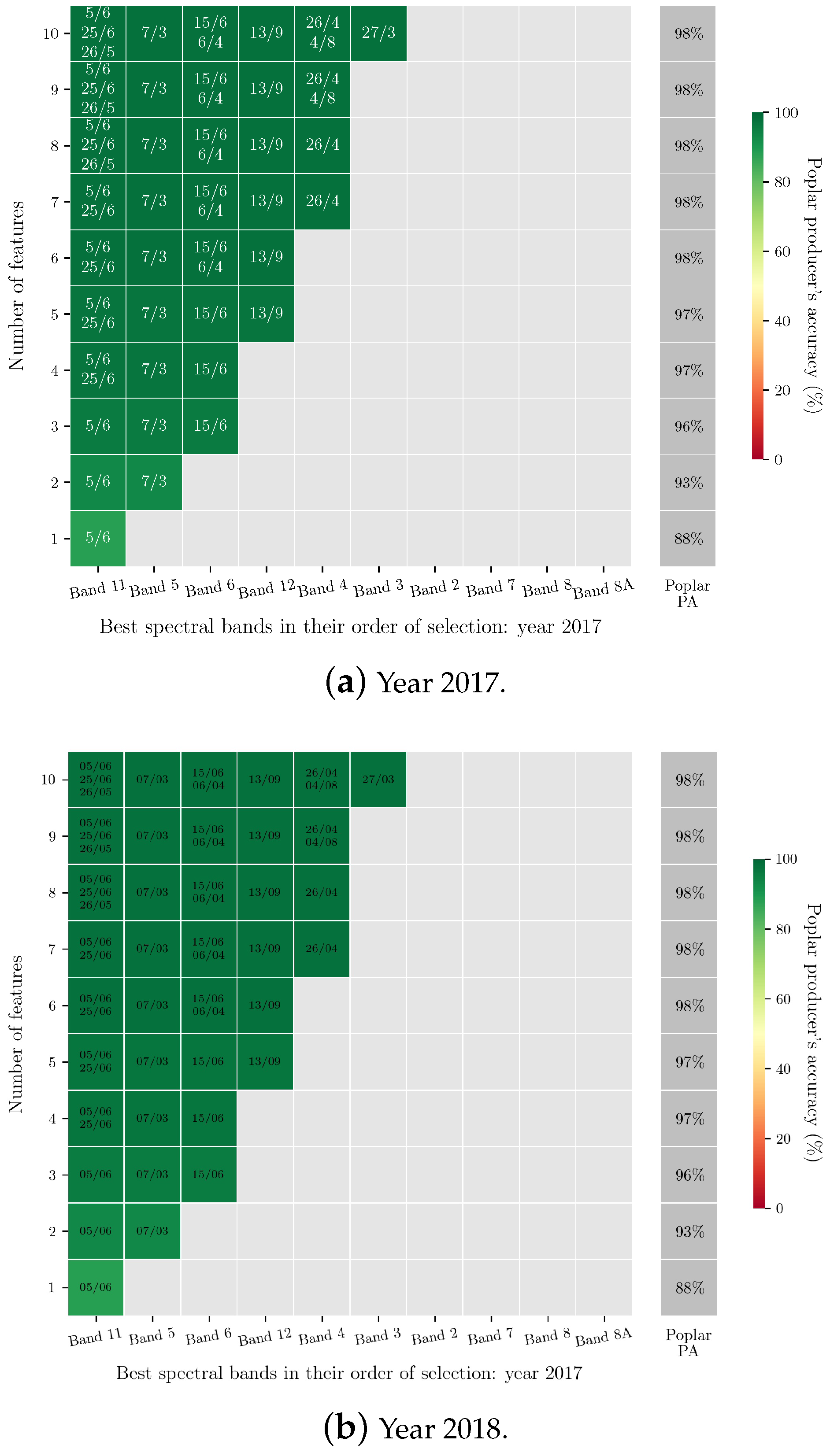
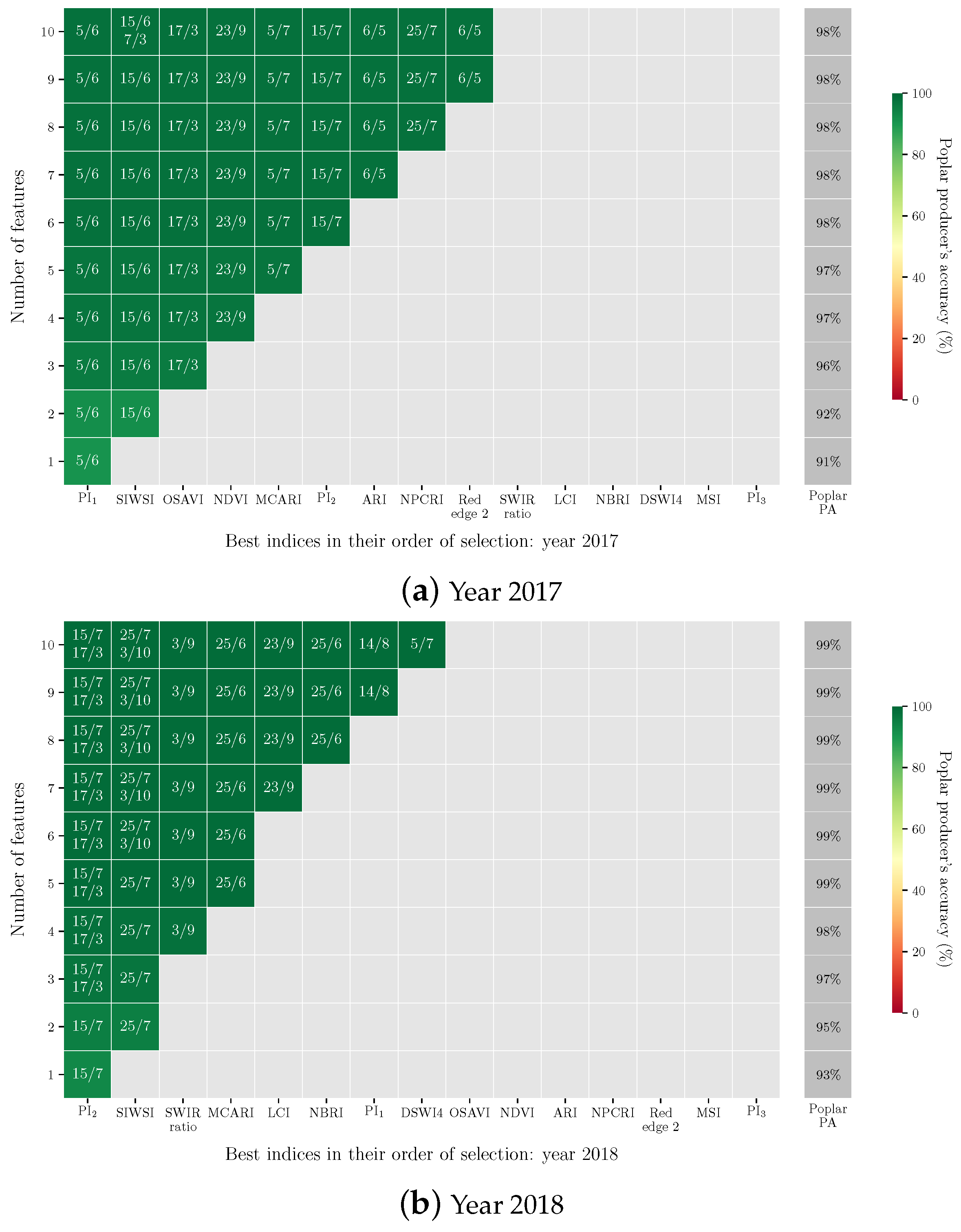


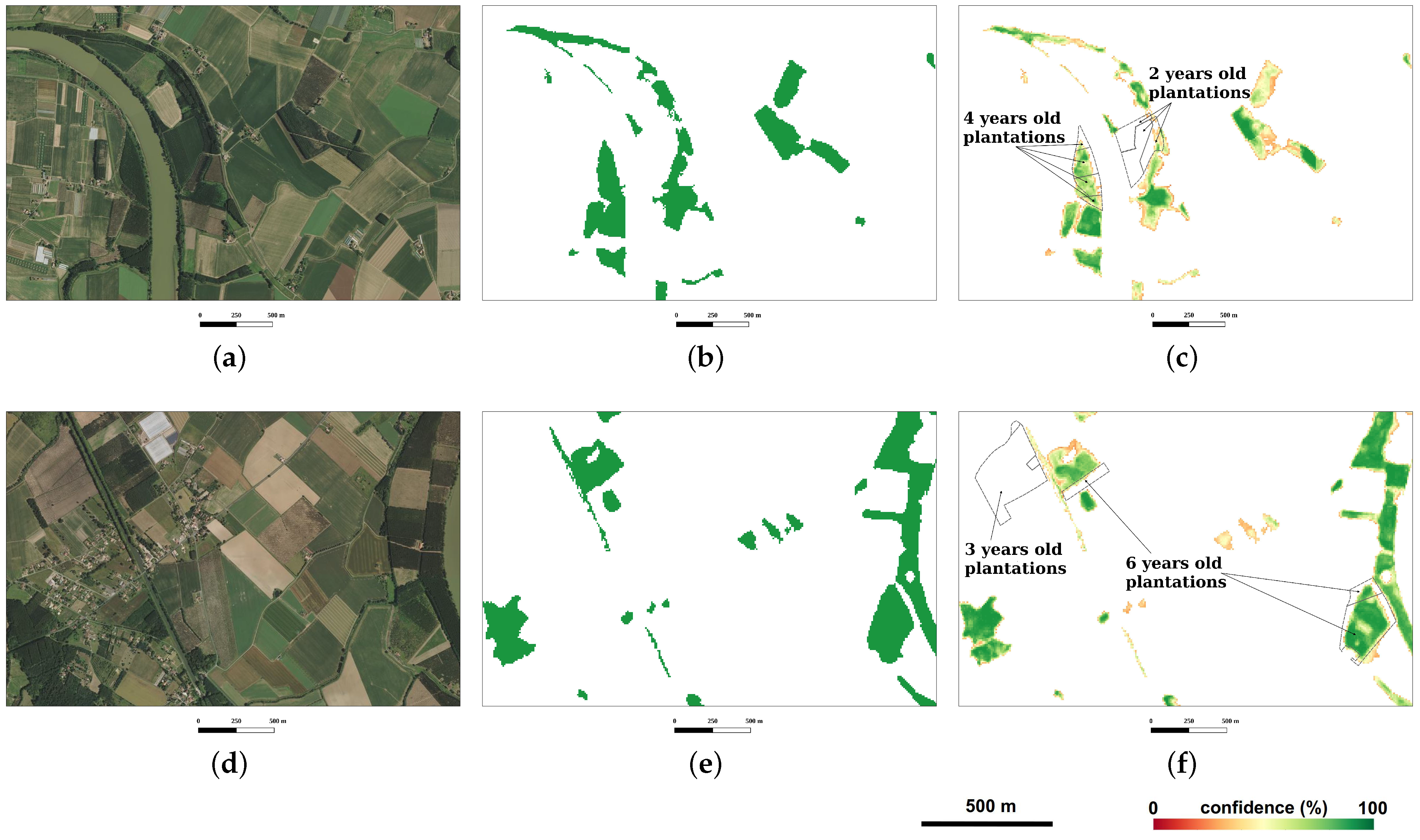


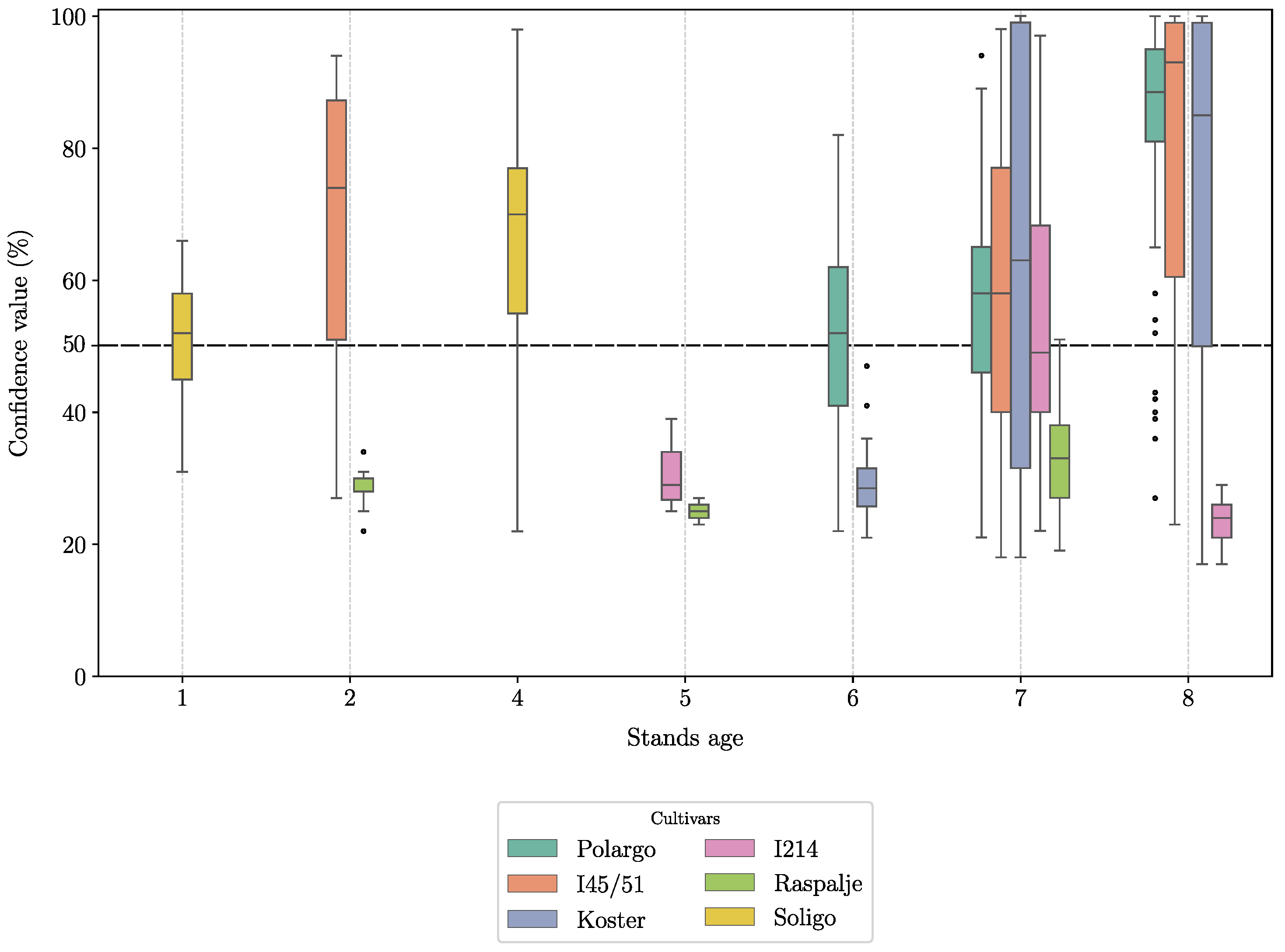

| Band | S2A | S2B | |||
|---|---|---|---|---|---|
| Central Wavelength (nm) | Bandwidth | Central Wavelength (nm) | Bandwidth | Spatial Resolution (m) | |
| B2 | 492.7 | 65 | 492.3 | 65 | 10 |
| B3 | 559.8 | 35 | 558.9 | 35 | 10 |
| B4 | 664.6 | 30 | 664.9 | 31 | 10 |
| B5 | 704.1 | 14 | 703.8 | 15 | 20 |
| B6 | 740.5 | 14 | 739.1 | 13 | 20 |
| B7 | 782.8 | 19 | 779.7 | 19 | 20 |
| B8 | 832.8 | 105 | 832.9 | 104 | 10 |
| B8A | 864.7 | 21 | 864.0 | 21 | 20 |
| B11 | 1613.7 | 90 | 1610.4 | 94 | 20 |
| B12 | 2202.4 | 174 | 2185.7 | 184 | 20 |
| Sample Size in Pixels per Class | ||||||||
|---|---|---|---|---|---|---|---|---|
| Year | Tile Code | Poplar (hybrid) (P. x eur/interamericana or Balsam P.) | Black locust (Robinia pseudoacacia L.) | European chestnut (Castanea sativa) | Oak (Quercus pubescens, petraea, robur L.) | European beech (Fagus sylvatica L.) | Closed Deciduous Forest (Mixed) | Open Deciduous Forest (Mixed) |
| 2017 | 31UEQ | 2500 | 2500 | NA | 2500 | 2500 | 2500 | 2500 |
| 30TYT | 4000 | 4000 | 4000 | 4000 | NA 1 | 4000 | 4000 | |
| 31TCJ | 7700 | 7700 | 7700 | 7700 | NA 1 | 7700 | 7700 | |
| 2018 | 31UEQ | 3700 | NA 1 | NA 1 | 3700 | 3700 | 3700 | 3700 |
| 30TYT | 3200 | 3200 | 3200 | 3200 | NA 1 | 3200 | 3200 | |
| 31TCJ | 5000 | 5000 | 5000 | 5000 | NA 1 | 5000 | 5000 | |
| Indices | Formulas | References | |
|---|---|---|---|
| Normalised Difference Vegetation Index | NDVI = | [52] | |
| Simple ratio Moisture Index | MSI = | [53] | |
| Simple ratio Disease Water Index 4 | DSWI4 = | [54] | |
| Normalised Pigment Chlorophyll ratio Index | NPCRI = | [55] | |
| Normalised Burned Ratio Index | NBRI = | [56] | |
| Shortwave Infrared Water Stress Index | SIWSI = | [57] | |
| Anthocyanin Reflectance Index | ARI = | [58] | |
| Soil Adjusted Vegetation Index | OSAVI = | [59] | |
| Leaf Chlorophyll Index | LCI = | [60] | |
| Modified Chlorophyll Absorption in Reflectance Index | MCARI = | [54] | |
| Red edge Index 2 | Red edge2 = | [61] | |
| SWIR ratio | SWIR ratio = | [62] | |
| Poplar Index 1 | PI = | Equation (1) | |
| Poplar Index 2 | PI = | Equation (2) | |
| Poplar Index 3 | PI = | Equation (3) | |
| Poplar Index 4 | PI = | Equation (4) |
| Single-Feature SFFS | Multi-Feature SFFS | |||||||
|---|---|---|---|---|---|---|---|---|
| Year | Poplar PA Scores | Bands | Indices | Multi-Bands | Multi-Indices | |||
| B5 | B11 | B12 | PI | SIWSI | ||||
| 2017 | validation score | 84% | 96% | 94% | 96% | 96% | 98% | 98% |
| test score | 57% | 87% | 89% | 92% | 89% | 93% | 94% | |
| 2018 | validation score | 96% | 97% | 96% | 98% | 97% | 99% | 99% |
| test score | 80% | 93% | 90% | 95% | 87% | 95% | 94% | |
| Tree Species | EWT (in g/cm2) | C (in g/cm2) | C (in g/cm2) |
|---|---|---|---|
| European beech (Fagus sylvatica L.) | 0.0046 | 33.11 | 13.68 |
| European aspen (Populus tremula L.) | 0.0065 | 33.34 | 10.88 |
| Northern red oak (Quercus rubra L.) | 0.0065 | 32.54 | 9.85 |
| European chestnut (Castanea sativa) | 0.0066 | 28.33 | 7.98 |
| Black locust (Robinia pseudoacacia L.) | 0.0076 | 28.83 | 8.44 |
| European ash (Fraxinus excelsior L.) | 0.0080 | 49.94 | 16.82 |
| European birch (Betula pendula) | 0.0081 | 27.85 | 8.86 |
| Downy oak (Quercus pubescens) | 0.0083 | 37.47 | 11.56 |
| Sycamore maple (Acer pseudoplatanus L.) | 0.0084 | 31.26 | 10.60 |
| White poplar (Populus alba L.) | 0.0089 | 42.65 | 16.50 |
| European alder (Alnus glutinosa L.) | 0.0090 | 47.71 | 15.67 |
| Carolina poplar (Populus x canadensis) | 0.0098 | 21.83 | 7.92 |
| White willow (Salix alba L.) | 0.0098 | 34.49 | 10.83 |
| English walnut (Juglans regia L.) | 0.0124 | 39.84 | 12.70 |
Publisher’s Note: MDPI stays neutral with regard to jurisdictional claims in published maps and institutional affiliations. |
© 2022 by the authors. Licensee MDPI, Basel, Switzerland. This article is an open access article distributed under the terms and conditions of the Creative Commons Attribution (CC BY) license (https://creativecommons.org/licenses/by/4.0/).
Share and Cite
Hamrouni, Y.; Paillassa, E.; Chéret, V.; Monteil, C.; Sheeren, D. Sentinel-2 Poplar Index for Operational Mapping of Poplar Plantations over Large Areas. Remote Sens. 2022, 14, 3975. https://doi.org/10.3390/rs14163975
Hamrouni Y, Paillassa E, Chéret V, Monteil C, Sheeren D. Sentinel-2 Poplar Index for Operational Mapping of Poplar Plantations over Large Areas. Remote Sensing. 2022; 14(16):3975. https://doi.org/10.3390/rs14163975
Chicago/Turabian StyleHamrouni, Yousra, Eric Paillassa, Véronique Chéret, Claude Monteil, and David Sheeren. 2022. "Sentinel-2 Poplar Index for Operational Mapping of Poplar Plantations over Large Areas" Remote Sensing 14, no. 16: 3975. https://doi.org/10.3390/rs14163975
APA StyleHamrouni, Y., Paillassa, E., Chéret, V., Monteil, C., & Sheeren, D. (2022). Sentinel-2 Poplar Index for Operational Mapping of Poplar Plantations over Large Areas. Remote Sensing, 14(16), 3975. https://doi.org/10.3390/rs14163975






